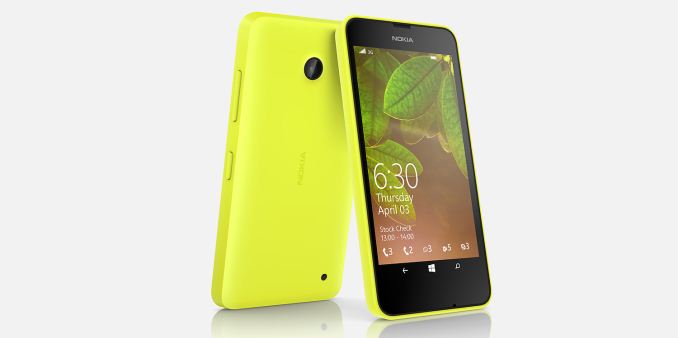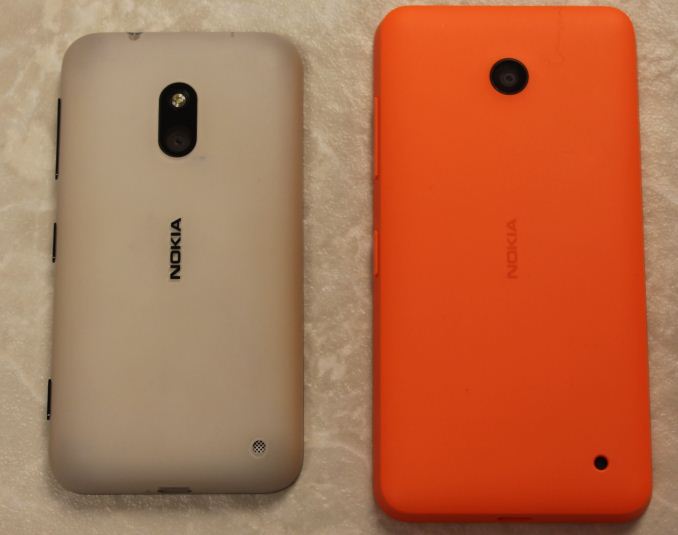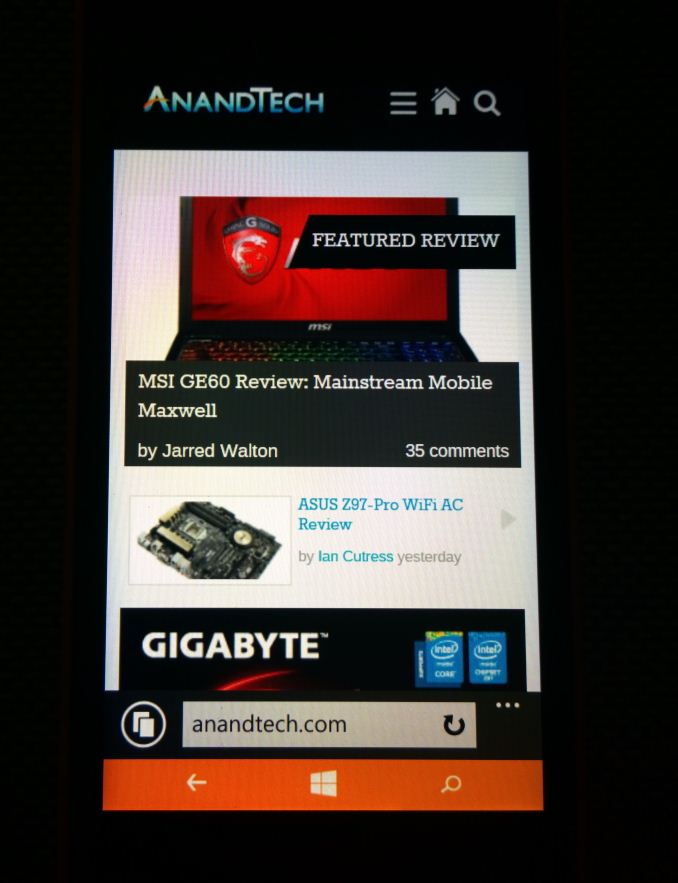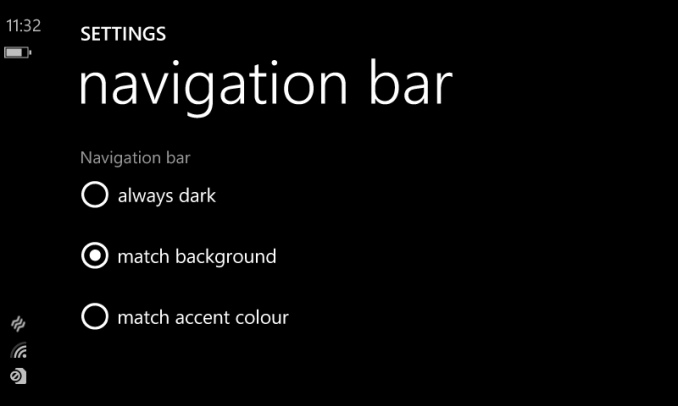Nokia Lumia 630 Review
by Brett Howse on July 22, 2014 8:00 AM EST- Posted in
- Smartphones
- Microsoft
- Nokia
- Mobile
- windows phone
Hardware
The first thing that anyone will ever do with a smartphone is hold it, so we will start with the design of the phone. If you have ever seen or held any Lumia phone, then you will instantly recognize the 630 as a Lumia. The polycarbonate back is much thinner and more flexible than the 620, but has an excellent matte texture to it which makes it easy to grip and hold. The design has progressed from the earlier Lumia models with removable backs, and now features nicely rounded corners, and an angular side which makes the device quite comfortable to hold on to.
As is often the case with Lumia phones, there are several colors to choose from and in this case you can get white, black, yellow, green, or the color I received as a review unit which is a nice bright orange. As someone who has always owned black phones, I have to say that I’ve grown to really like the orange.
The power and volume buttons can be found on the right side of the device, with the micro USB port on the bottom, and the 3.5 mm jack on top. The back has the 5 MP camera sensor, a speaker hole, and a very faint Nokia logo. There is no fake chrome, or fake leather. This is a plastic phone that is made out of quality plastic, and with the small by today’s standard display of 4.5”, the phone fits nicely in the hand and is quite comfortable to hold.
The back of the device peels off, unlike older Lumia phones which definitely popped off. Behind the removable back cover we get easy access to the SIM slot (or dual SIMs if applicable) as well as the replacable battery and a microSD slot.
 Lumia 620 (left) vs Lumia 630 (right)
Lumia 620 (left) vs Lumia 630 (right)
The move to on-screen buttons for the back, home, and search keys was something that took me no time to adjust to. You can set the device to provide haptic feedback of button presses, and in that sense they work and feel exactly like the capacitive buttons of most phones. I also accidentally triggered the buttons less than the hardware buttons of other phones I’ve used, which I attribute to not having the buttons so low on the device, so if I rest my thumb at the bottom, I don’t hit search. A nice touch to the on-screen buttons is you can customize the navigation bar color to be always dark, match the background, or match the accent color.
The one thing I do miss though is the camera button, and perhaps that’s because Windows Phone 8.1 isn’t ready to give this button up yet. There’s no easy way to access the camera from the lock screen like on competing operating systems, and with other Windows Phones that’s not an issue because of the physical button to launch the camera. The workaround on this device is that one of the quick action buttons in the action center is set to the camera function out of the box. It is not the ideal fix, and I hope they add a slide right for camera experience to the start and lock screens in a future update to address this issue.
As far as the specifications, the Lumia 630 is also the first Windows Phone to sport the Snapdragon 400 class of SoC. This brings the MSM8226 model which is a quad-core Cortex A7 CPU at 1.2 GHz, Adreno 305 Graphics, integrated modem, and improved ISP over the Snapdragon S4 of the previous generation. Also in-line with the Lumia 520 and 620 is the 512 MB of RAM which is a shame in 2014. Windows Phone as an OS gets by just fine with 512 MB of RAM, but many games in the store are limited to devices with at least 1 GB of RAM, so it would have been nice to see the 630 include the 1 GB to open the device to all apps in the store. The full specifications are listed below.
| Lumia 630 Specifications | ||||
| Nokia Lumia 520 | Nokia Lumia 620 | Nokia Lumia 625 | Nokia Lumia 630 | |
| CPU |
Qualcomm Snapdragon S4 Plus MSM8227 Krait Dual-Core 1.0 GHz |
Qualcomm Snapdragon S4 Plus MSM8227 Krait Dual-Core 1.0 GHz |
Qualcomm Snapdragon S4 Plus MSM8930 Krait Dual-Core 1.2 GHz |
Qualcomm Snapdragon 400 MSM8226 Cortex A7 Quad-Core 1.2 GHz |
| RAM/NAND | 512 MB / 8 GB + MicroSD | 512 MB / 8 GB + MicroSD | 512 MB / 8 GB + MicroSD | 512 MB / 8 GB + MicroSD |
| Display Size and Resolution | 4.0" 800x480 | 3.8" 800x480 | 4.7" 800x480 | 4.5" 854x480 |
| Network | GSM, GPRS, EDGE, UMTS, HSPA+ up to 21 Mbps | GSM, GPRS, EDGE, UMTS, HSPA+ up to 21 Mbps | GSM, GPRS, EDGE, UMTS, DC HSPA+, LTE up to 100 Mbps | GSM, GPRS, EDGE, UMTS, HSPA+ up to 21 Mbps |
| Dimensions | 119.9 x 64 x 9.9 (mm) | 115.4 x 61.1 x 11 (mm) | 133.2 x 72.2 x 9.2 (mm) | 129.5 x 66.7 x 9.2 (mm) |
| Weight | 124 g | 127 g | 159 g | 134 g |
| Camera | 5MP rear camera, 1.4 µm pixels, 1/4" CMOS size, F/2.4, 28 mm focal length, No Flash, No FFC | 5MP rear camera, 1.4 µm pixels, 1/4" CMOS size, F/2.4, 28 mm focal length, LED Flash, VGA FFC | 5MP rear camera, 1.4 µm pixels, 1/4" CMOS size, F/2.4, 28 mm focal length, LED Flash, VGA FFC | 5MP rear camera, 1.4 µm pixels, 1/4" CMOS size, F/2.4, 28 mm focal length, No Flash, No FFC |
| Battery | 1430 mAh 3.7 V (5.291 Wh) | 1300 mAh 3.7 V (4.81 Wh) | 2000 mAh 3.7 V (7.4 Wh) | 1830 mAh 3.7 V (6.771 Whr) |
| Current Shipping OS | Windows Phone 8.0 with Black Firmware | Windows Phone 8.0 with Black Firmware | Windows Phone 8.0 with Black Firmware | Windows Phone 8.1 with Cyan Firmware |
| Connectivity | 802.11 b/g/n + BT 4.0, USB2.0, MPT, DLNA, FM Radio | 802.11 a/b/g/n + BT 4.0, USB2.0, MPT, DLNA, NFC | 802.11 b/g/n + BT 4.0, USB2.0, MPT, DLNA, FM Radio | 802.11 b/g/n + BT 4.0, USB2.0, MPT, DLNA, FM Radio |
| Location Technologies | Cellular and Wi-Fi network positioning, A-GPS, A-GLONASS | Cellular and Wi-Fi network positioning, A-GPS, A-GLONASS, Magnetometer | Cellular and Wi-Fi network positioning, A-GPS, A-GLONASS | Cellular and Wi-Fi network positioning, A-GPS, A-GLONASS, BeiDou |
| SIM Size | MicroSIM | MicroSIM | MicroSIM | MicroSIM (Dual SIM Optional) |
There’s not too many surprises here. Wi-Fi is 802.11n and not ac, the 630 doesn’t have LTE (although the 635 does for a bit more money) and the camera is decidedly low end. 8 GB of NAND may seem low, but to get to this price it’s not unexpected. You can add up to 128 GB of storage via microSD though, and Windows Phone 8.1 now allows apps to be installed on the SD card, so storage isn’t really an issue.











83 Comments
View All Comments
LiviuTM - Tuesday, July 22, 2014 - link
Correction to correction: Page 7, actuallyYofa - Tuesday, July 22, 2014 - link
riders fan?! ignore!Wolfpup - Tuesday, July 22, 2014 - link
I've got an iPhone 5s, but I've gotten Nokia 520s for two people now. I love it, they love it. It's really a great phone, and like my iPhone, there's just something pleasurable about using it. It (like real Windows) also runs a lot faster than Android on comparable hardware.The biggest issue I have with Windows Phone right now is that like Android it's stuck getting OS updates from the carrier. Microsoft needs to switch to an Apple/Windows model of controlling the updates themselves. That said, at least so far even the 520 is getting every single update Microsoft does...which I guess still beats Android save for the Nexus devices.
My only complain with this 630 is the RAM. I realize hitting a $100 price point is kind of crazy, and the 520 runs fine, but still...1GB would definitely be the first upgrade I'd want for this.
Considering I still carry an iPod anyway, I'd seriously consider a Windows Phone for myself if my iPhone died, just because of the price, though I think I'd go with the 6" model.
Wolfpup - Tuesday, July 22, 2014 - link
Forgot to mention...I do wonder about the CPU choice. Obviously it works (and as mentioned you can't compare iOS or Windows Phone or even real Windows to Android as Android requires much beefier hardware to get the same performance)...but I am curious about using a quad A7. A7 supposedly tries to get close to A9 performance with a smaller die area, but then Krait is already A9+. Not sure it makes sense to replace 2 Kraits with 4 A7s...but oh well, I'm sure it's fine!Scary how much faster Apple's Cyclone is than everything else. Right now it doesn't even matter...it's mostly overkill for a phone, but probably not for the iPad, and certainly not for a more OS X-like iPad...
rgba - Tuesday, July 22, 2014 - link
In the HTC One mini 2 review, Anand mentioned that Cortex-A7 actually delivers slightly higher IPC than Krait 200. Considering that, quad A7 running at 1190 MHz is a clear improvement over dual Krait 200 @ 972 MHz.ruggia - Wednesday, July 23, 2014 - link
Higher IPC is meaningless when A7 runs on thumb instructions and is In-order, as opposed to Krait which runs full armv7 and is out of orderextide - Thursday, July 24, 2014 - link
Not true, A7 runs the full ARMv7 ISA, not just thumb. The cortex M series chips run thumb, but ALL cortex A class cpu's run full ARM ISA's. (ARM7 in this case obviously, but the A5x cores run ARMv8).It is in order, and Krait is out of order, but IPC is very much NOT meaningless!
tuxRoller - Wednesday, July 23, 2014 - link
I guess you missed this:The Lumia 630 handily beats the Moto G in memory performance, but the Moto G wins the rest of the tests. We’re still looking at a performance deficit for most tasks with Windows Phone 8.1 which is something Microsoft will need to work on going forward.
So. despite the Android VM deficit it still manages to at least keep up with, and generally surpass, win8.x. Can't wait till the new ART drops.
Flunk - Tuesday, July 22, 2014 - link
"If you play a lot of games, avoid this device."If you play a lot of games, avoid Windows Phone. The selection is just not fantastic.
octonysa - Tuesday, July 22, 2014 - link
Computer World blog says Google search banned from the 630 and 930. That kills this phone (IMO).